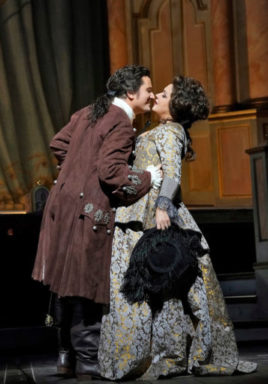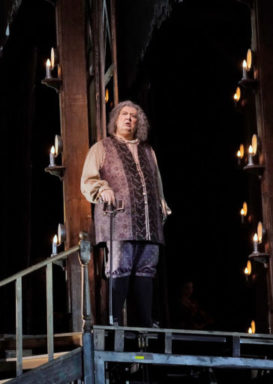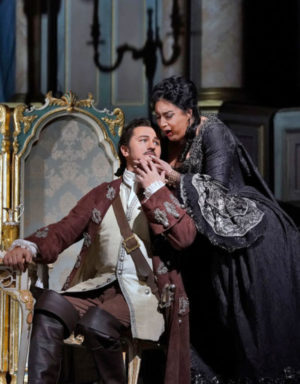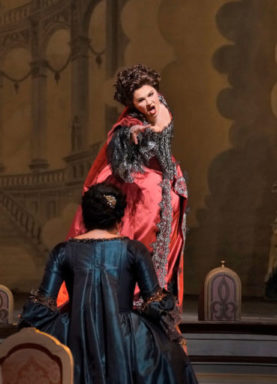New York, Metropolitan Opera season 2018 / 2019
“ADRIANA LECOUVREUR”
Opera in four acts, libretto by Arturo Colautti, based on the play by Eugène Scribe and Ernest Legouvé. Music by Francesco Cilea
Adriana Lecouvreur ANNA NETREBKO
Il Prince de Bouillon MAURIZIO MURARO
La Principessa de Bouillon ANITA RACHVELISHVILI
Maurizio PIOTR BECZAŁA
Michonnet AMBROGIO MAESTRI
Mlle Jouvenot SARAH JOY MILLER
Poisson TONY STEVENSON
Mlle Dangeville SAMANTHA HANKEY
Quinault PATRICK CARFIZZI
Abbé Chazeuil CARLO BOSI
Major-Domo CHRISTIAN ROZAKIS
Mlle. Duclos SNEZHANA CHERNOVA
Paris KFIR DANIELI
Mercury BRADLEY SHELVER
Jupiter ARTHUR LAZALDE
Juno ERIN KERNION
Venus CAJAI FELLOWS JOHNSON
Minerva SARAH KAY MARCHETTI
Discord MARIA PHEGAN
Orchestra and Chorus of the Metropolitan Opera
Conductor Gianandrea Noseda
Chorus Master Donald Palumbo
Production Sir David McVicar
Set Designer Charles Edwards
Costume Designer Brigitte Reiffenstuel
Lighting Designer Adam Silverman
Choreographer Andrew George
New York, 4 January, 2019
 On the subway beside me after a performance of Cilea’s Adriana Lecouvreur at the Met, two ladies of a certain age were expressing their delight with the evening’s event—and very pleased they were! As well might they be, with the tip-top cast and the charmingly “realistic” David McVicar production in Charles Edwards’ sets, which place us backstage in the Comédie Française, of which Adrienne Lecouvreur was the unrivaled star in 1730, and then retains that backstage “motif” for every other sphere of her life and the opera’s plot (high society, low intrigue, deathbed) to proclaim the theatricality of life in rococo Paris. The production, after the common way of such things, was introduced at Covent Garden nine years ago and has also been seen in Vienna, Paris, Barcelona and San Francisco. “The thing I don’t understand,” one of my two ladies complained, “is why this opera isn’t given more often.” Well, it’s done infrequently because there isn’t much substance to the pretty score, which has the style and brevity and visible activity of Verismo but little of the passion that opera audiences expected on the lyric stage in 1902. Instead of chronicling the murderous and amorous misbehavior of peasant or laborer classes for the delight of civilized urban opera-goers, Adriana dredges up one of the long-dead Eugène Scribe’s costume melodramas based (shakily) on real people who lived long ago, and surrounds them with lacy faux-archaic tunefulness. The great climax of the drama is not an aria at all but an unaccompanied spoken “tirade” from Racine’s Phèdre. Singers in the heyday of Verismo preferred more blood and thunder in their music. In Adriana, colorful shmattas are half the fun, and here Brigitte Reiffenstuhl’s costumes did not stint—except that, in 1730, no one appeared at any grand occasion in her or his own unpowdered hair, but only in formal white wigs, even on the battlefield and certainly in the boudoir. Just look at a still from any previous production of the opera. This one establishes its twenty-first-century origins by omitting all the wigs. (Did this save them money?) Otherwise, we are indeed in Paris in 1730, backstage at a performance by the sublime Lecouvreur, where the love affairs of Maurice de Saxe (Maurizio) tangle awkwardly with his aspirations to ascend the throne of the duchy of Courland.
On the subway beside me after a performance of Cilea’s Adriana Lecouvreur at the Met, two ladies of a certain age were expressing their delight with the evening’s event—and very pleased they were! As well might they be, with the tip-top cast and the charmingly “realistic” David McVicar production in Charles Edwards’ sets, which place us backstage in the Comédie Française, of which Adrienne Lecouvreur was the unrivaled star in 1730, and then retains that backstage “motif” for every other sphere of her life and the opera’s plot (high society, low intrigue, deathbed) to proclaim the theatricality of life in rococo Paris. The production, after the common way of such things, was introduced at Covent Garden nine years ago and has also been seen in Vienna, Paris, Barcelona and San Francisco. “The thing I don’t understand,” one of my two ladies complained, “is why this opera isn’t given more often.” Well, it’s done infrequently because there isn’t much substance to the pretty score, which has the style and brevity and visible activity of Verismo but little of the passion that opera audiences expected on the lyric stage in 1902. Instead of chronicling the murderous and amorous misbehavior of peasant or laborer classes for the delight of civilized urban opera-goers, Adriana dredges up one of the long-dead Eugène Scribe’s costume melodramas based (shakily) on real people who lived long ago, and surrounds them with lacy faux-archaic tunefulness. The great climax of the drama is not an aria at all but an unaccompanied spoken “tirade” from Racine’s Phèdre. Singers in the heyday of Verismo preferred more blood and thunder in their music. In Adriana, colorful shmattas are half the fun, and here Brigitte Reiffenstuhl’s costumes did not stint—except that, in 1730, no one appeared at any grand occasion in her or his own unpowdered hair, but only in formal white wigs, even on the battlefield and certainly in the boudoir. Just look at a still from any previous production of the opera. This one establishes its twenty-first-century origins by omitting all the wigs. (Did this save them money?) Otherwise, we are indeed in Paris in 1730, backstage at a performance by the sublime Lecouvreur, where the love affairs of Maurice de Saxe (Maurizio) tangle awkwardly with his aspirations to ascend the throne of the duchy of Courland.
Maurizio (Piotr Beczala) is having dangerous liaisons with both the Princesse de Bouillon (Anita Rachvelishvili), whose political influence is useful just as long as her husband (Maurizio Muraro) doesn’t find out about it, and with Adriana herself (Anna Netrebko), star of the Comédie, who—poor naïve child—is unaware that the adjutant she adores is none other than the famous Maurizio in disguise. And though Adriana does not know it, the chief of the Comédie, Michonnet (Ambrogio Maestri) is also in love with her, and hopeless asides touch our hearts between passionate outbursts from the others. Let’s say here that if you produce this slight but melodious sort of opera with a cast on this level, you are going to make a great many opera lovers happy whatever the vehicle. All three of the leads look handsome and emotionally disheveled (it’s their not having powdered wigs proper to their extreme emotional states), and they hurl themselves about the stage as if the story meant everything to them. It’s too bad they weren’t giving their all to a meatier opera, to La Gioconda or La Forza del Destino. But Adriana will do in a pinch.
Rachvelishvili), whose political influence is useful just as long as her husband (Maurizio Muraro) doesn’t find out about it, and with Adriana herself (Anna Netrebko), star of the Comédie, who—poor naïve child—is unaware that the adjutant she adores is none other than the famous Maurizio in disguise. And though Adriana does not know it, the chief of the Comédie, Michonnet (Ambrogio Maestri) is also in love with her, and hopeless asides touch our hearts between passionate outbursts from the others. Let’s say here that if you produce this slight but melodious sort of opera with a cast on this level, you are going to make a great many opera lovers happy whatever the vehicle. All three of the leads look handsome and emotionally disheveled (it’s their not having powdered wigs proper to their extreme emotional states), and they hurl themselves about the stage as if the story meant everything to them. It’s too bad they weren’t giving their all to a meatier opera, to La Gioconda or La Forza del Destino. But Adriana will do in a pinch.
Netrebko, whose voice has become ever deeper and grander, toys with tentative expressiveness (does Maurizio mean the things he says to her?) or grinding out chesty rage as she faces down her aristocratic rival. She is passionate, self-deprecating, often touching, especially in the anguish of “Poveri fiori.” My only regret about the size and intensity of her instrument in this opera is that it so closely resembles the old-fashioned gutsy mezzo of Rachvelishvili. In an opera when the tenor must choose between them (especially since he is actively romantically involved with both), it would be nice to have a clearer audible contrast to explain his preference. The Princesse is written for impassioned, outraged utterance; we believe she is obsessed and we understand why Maurizio has tired of it. Adriana’s soprano should strike a gentler, more adorable tone (as when Caballé and Freni sang it). But this lack of contrast did not interfere with the sensual pleasure of experiencing Netrebko in the role.
 Rachvelishvili is currently the singer New York’s musical media are shouting about. Her Carmen has long been a crowd-pleaser here, but this season she has cut loose as Amneris and (upcoming) Dalila. She is an actress of unrelieved tension, feeling the frustrations that then pour into room-filling song, and audiences respond powerfully. But where Carmen, the girl of the streets, gave her just the right scope (some other Met Carmens have been far too ladylike, recently), the Princesse de Bouillon is an aristocrat, and she prowls the stage like a kitchen wench who has stolen her ladyship’s gown and jewels (though not her wig). In a part with only two scenes, who spends most of her time in one of them offstage hidden in a closet, Rachvelishvili made a shattering, an outstanding effect. But was it the right effect?
Rachvelishvili is currently the singer New York’s musical media are shouting about. Her Carmen has long been a crowd-pleaser here, but this season she has cut loose as Amneris and (upcoming) Dalila. She is an actress of unrelieved tension, feeling the frustrations that then pour into room-filling song, and audiences respond powerfully. But where Carmen, the girl of the streets, gave her just the right scope (some other Met Carmens have been far too ladylike, recently), the Princesse de Bouillon is an aristocrat, and she prowls the stage like a kitchen wench who has stolen her ladyship’s gown and jewels (though not her wig). In a part with only two scenes, who spends most of her time in one of them offstage hidden in a closet, Rachvelishvili made a shattering, an outstanding effect. But was it the right effect?
Caught between these two blustering females, Piotr Beczala’s Maurizo looked the part, peacock strut and all, and sang unsubtly. The account of his heroics at the Battle of Mittau—the longest bit of vocalism in Act III, which is otherwise cluttered with ballet and tirade—was sung with notable masculine gusto, hurled out triumphantly to cow the fops about court. But his love music, taming Adriana, soothing the Princesse, attending the tragic birthday party of Act IV, demonstrated a similar bluster and little of the mellow romantic. I hope he will calm down in later performances.
Ambrogio Maestri sang Michonnet, the evening’s most tragic figure, in a way, since his love fo r Adriana is one he dares not express aloud (except to us). Stout and bearlike, Maestri’s looks are ideal for this role, and his smooth basso, full of character that never defies the principles of bel canto, provides a warm, polished and affecting vision of the opera’s odd man out. Among the show’s many minor figures (Scribe always gave the character roles something amusing to do), Carlo Bosi provided serpentine charm for the salon priest who attempts to seduce the Princesse while serving as go-between for her husband’s amours. Gianandrea Noseda massaged the score into the glittering sheen that dazzled audiences weary of Puccini’s familiar thrills. The tunes may be repetitious (here it comes again! Up another step!) and they may outstay their welcome after a day or two worming the ear, but as I said above, the audience who had gratefully forgotten the last time they’d heard it were overjoyed to hear Adriana sounding so fresh and worthwhile.Photo: Ken Howard / Met Opera
r Adriana is one he dares not express aloud (except to us). Stout and bearlike, Maestri’s looks are ideal for this role, and his smooth basso, full of character that never defies the principles of bel canto, provides a warm, polished and affecting vision of the opera’s odd man out. Among the show’s many minor figures (Scribe always gave the character roles something amusing to do), Carlo Bosi provided serpentine charm for the salon priest who attempts to seduce the Princesse while serving as go-between for her husband’s amours. Gianandrea Noseda massaged the score into the glittering sheen that dazzled audiences weary of Puccini’s familiar thrills. The tunes may be repetitious (here it comes again! Up another step!) and they may outstay their welcome after a day or two worming the ear, but as I said above, the audience who had gratefully forgotten the last time they’d heard it were overjoyed to hear Adriana sounding so fresh and worthwhile.Photo: Ken Howard / Met Opera
New York, Metropolitan Opera: “Adriana Lecouvreur”
